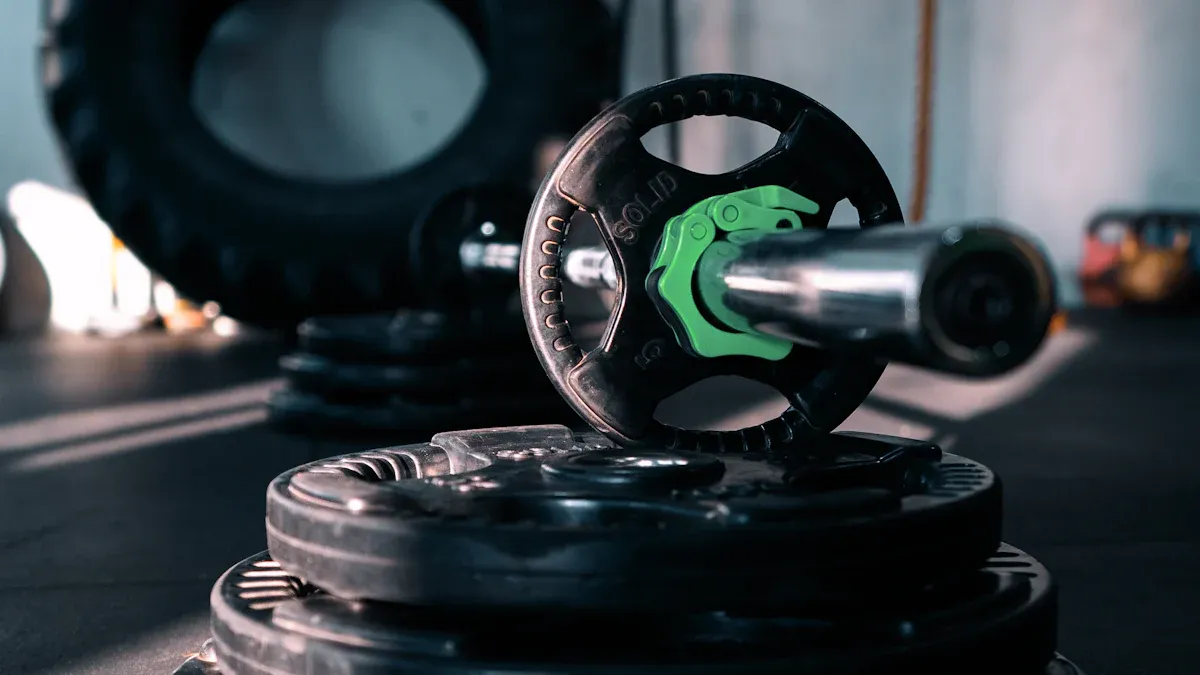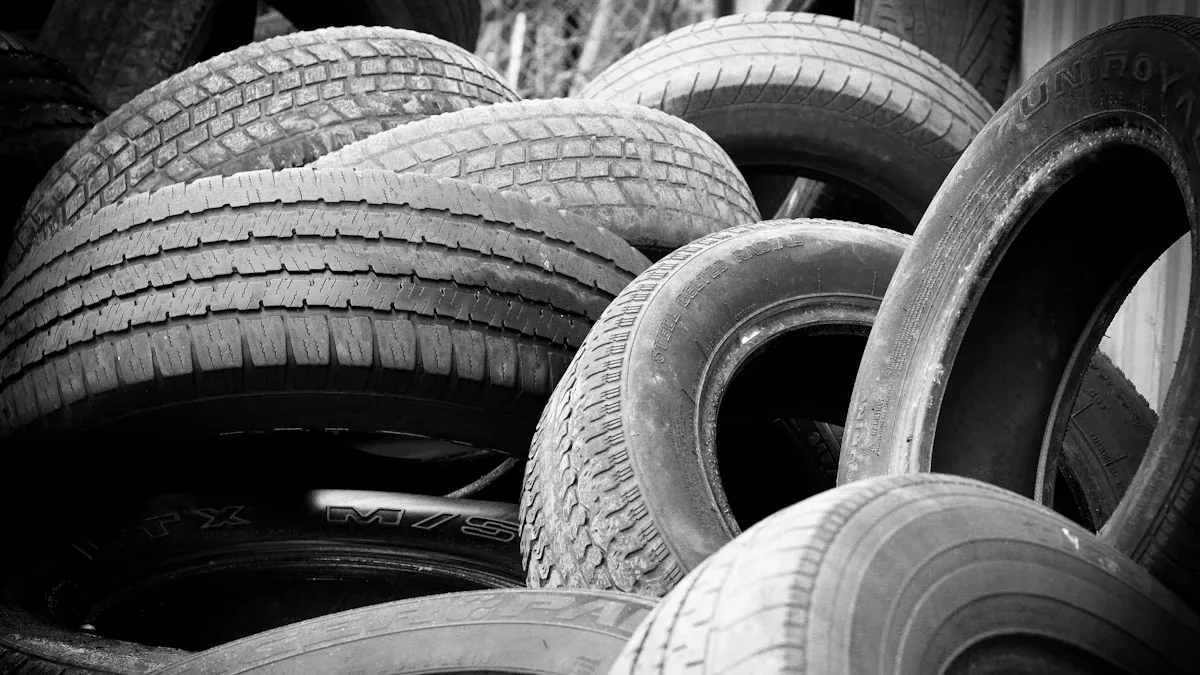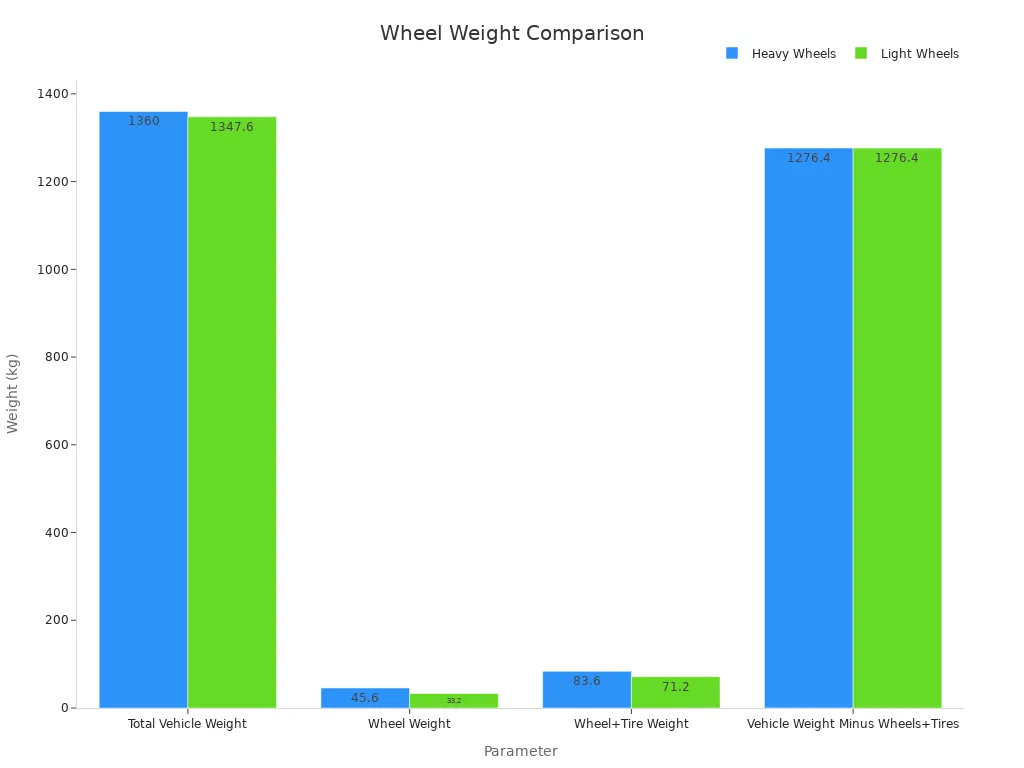

fortuneau
June 23, 2025
What Happens to Vehicle Performance When Wheel Tire Weight Increases

When you choose heavier tires and wheels, you change how your car feels and works. The extra wheel tire weight makes your vehicle performance drop. You may notice slower acceleration and higher fuel use. For example, tests show that switching to heavier wheels on a BMW 3 Series lowered fuel economy from 22.8 mpg to 21.1 mpg. The effect of wheel weight on performance is clear in both speed and fuel costs.
| Tire Rolling Resistance Coefficient | % Increase in Fuel Consumption |
|---|---|
| 0.007 | Baseline |
| 0.008 | +1-2% |
| 0.009 | +2-4% |
Lightweight wheels and tires help your car move better and save money over time.
Wheel Tire Weight and Acceleration

Slower Acceleration Explained
When you add heavier wheels and tires to your car, you make it harder for your vehicle to speed up. The engine must work harder to move the extra weight. This slows down your acceleration and can make your car feel less lively. For example, a study compared two sets of wheels and tires. One set was heavier by about 21 pounds. This extra weight led to a loss of about 2 horsepower. Even a small increase in wheel tire weight can make your car slower.
| Parameter | Heavy Wheels (BBS RSII) | Light Wheels (OZ Ultraleggera) |
|---|---|---|
| Total Vehicle Weight (kg) | 1360 | 1347.6 |
| Wheel Weight (kg) | 45.6 | 33.2 |
| Wheel + Tire Weight (kg) | 83.6 | 71.2 |
| Vehicle Weight Minus Wheels+Tires (kg) | 1276.4 | 1276.4 |
| Wheel+Tire Weight as % of Total | 6.15% | 5.28% |
| Ratio of Vehicle Weight Minus Wheels+Tires to Wheels+Tires | 15.27 | 17.93 |
| Average Acceleration Time (seconds) | 5.70 | 5.66 |
| Acceleration Time Difference (%) | N/A | 0.70% |
You can see that reducing tire weight by less than 1% of the total vehicle weight improved acceleration time by about 0.7%. This shows how even small changes in wheel and tire weight can affect your vehicle performance.

Increased Rotational Mass and Engine Load
Heavier wheels and tires do not just add weight. They also increase what is called rotational mass. Your engine must use more energy to spin heavier wheels. This means the engine faces a higher load when you press the gas pedal. You may notice the engine revs drop more when you try to speed up quickly. Here are some key points:
- Heavier rotating parts need more energy to start spinning.
- The engine works harder and cylinder pressure rises during acceleration.
- Lighter wheels and tires help the engine respond faster and use less energy.
Racing teams often choose lightweight wheels because they know this helps with quicker acceleration and better performance. In daily driving, you may not race, but you still feel the difference when your car responds faster to your input.
Real-World Impact on Throttle Response
You feel the effect of wheel tire weight every time you press the gas pedal. Heavier tires slow down how quickly your car reacts. Real-world tests with electric vehicles show that adding weight to the wheels makes the car less responsive. The throttle input takes longer to turn into movement. When you use lighter wheels and tires, your car feels more agile and reacts faster to your commands.
Many drivers notice that lightweight wheels give them better throttle response and improved handling. High-performance cars and racing vehicles use this trick to stay fast and sharp on the road or track. If you want your car to feel more lively and fun, choosing lighter wheels and tires can make a big difference in your driving experience.
Tip: If you want quicker acceleration and better vehicle performance, consider using lightweight wheels and tires. This change can help your car respond faster and use less fuel.
Wheel Tire Weight and Braking Performance
Longer Braking Distances
When you add heavier wheels and tires to your car, you make it harder for your vehicle to stop quickly. The extra weight increases the force needed to slow down. Empirical tests show that heavier wheels and tires can increase braking distance by nearly 5 meters when stopping from 100 km/h. This means your car will take longer to come to a complete stop in an emergency. Even a small increase in wheel tire weight can have a big impact on vehicle performance, especially when you need efficient braking. You want your car to stop as soon as possible to stay safe on the road.
Brake Wear and Safety Concerns
Heavier wheels and tires do not just affect how quickly you stop. They also cause your brakes to work harder every time you press the pedal. Studies from the European Monitoring and Evaluation Programme and the USEPA MOVES model show that increased vehicle mass leads to higher brake wear. When you drive with heavier wheels, your brake pads and rotors wear out faster. An experimental study found that increasing vehicle mass by up to 23% leads to more brake work and faster brake pad wear. The study used real-world data from passenger cars and showed that brake wear rates go up as the load increases. This means you may need to replace your brake pads more often, which can cost you more money and time. Worn brakes also reduce your safety, especially in wet or slippery conditions.
How Heavier Wheels Affect Stopping Power
You may wonder how heavier wheels change your car’s stopping power. Several studies and crash simulations help explain this effect:
- Heavier wheels increase the force needed to slow down your car.
- A study showed that increasing tire diameter, which raises rotational inertia, caused a 10% loss in brake efficiency.
- Braking torque drops when you use heavier wheels. For example, tests measured 465 N·m on lighter wheels and only 395 N·m on heavier ones.
- Heavier wheels can affect vehicle stability during hard stops. Your car may drift or lose control more easily.
- The contact patch between your tires and the road must handle more energy, which can lead to less stable braking.
You want your car to have strong and reliable stopping power. Choosing lighter wheels and tires helps your brakes work better and keeps you safer. Good performance in braking is just as important as acceleration or handling. Always think about how wheel tire weight affects every part of your driving experience.
Wheel Tire Weight and Handling
Less Responsive Steering
When you add more wheel tire weight, you may notice your steering feels slower and less direct. Your car does not react as quickly when you turn the wheel. Engineers use tests like step and sinusoidal steering input to measure how fast your car responds. They look at metrics such as yaw velocity response time and steering sensitivity. These tests show that extra weight can delay your car’s reaction to your steering. You might feel a lag, especially during quick maneuvers. This makes it harder to achieve responsive handling, which is important for both safety and fun driving.
Suspension Performance and Unsprung Weight
Your car’s suspension works best when it can keep the tires in contact with the road. When you increase unsprung weight by using heavier wheels and tires, the suspension has to work harder. The unsprung mass includes everything not supported by the springs, like wheels, tires, and brakes. More unsprung weight changes how your suspension moves. It can cause more wheel hop and reduce the time your tires stay on the road. This means you lose some improved grip, especially on bumpy roads. The contact patch—the area where your tires touch the ground—may not stay steady, which can lower your car’s performance in corners.
Note: Keeping unsprung weight low helps your suspension react faster and keeps your tires gripping the road.
Changes in Cornering and Stability
Heavier wheels and tires can change how your car feels in turns. You may notice more body roll or a slower response when you steer into a corner. The contact patch can shift or lose pressure, making your car less stable. You might also feel more understeer, where the car does not turn as much as you want. This happens because the extra weight increases the force on the outside tires during a turn. Your car’s performance in sharp corners or emergency maneuvers can drop. Choosing lighter wheels and tires helps you keep better control and enjoy a safer, more stable ride.
Wheel Tire Weight and Ride Comfort

Impact on Suspension Response
When you increase the weight of your wheels and tires, your car’s suspension has to work harder. The suspension system tries to keep your ride smooth by absorbing bumps and dips in the road. Heavier tires add to the unsprung mass, which makes it more difficult for the suspension to react quickly. Scientific studies show that if you reduce unsprung mass by 10%, you can improve ride comfort by about 6%. This happens because lighter tires allow the suspension to move more freely, reducing the vibrations that reach you inside the car. Car and Driver tests also found that larger, heavier wheels—like 19-inch models—make the ride feel harsher and put extra strain on the suspension. Smaller, lighter wheels and tires help your car feel more controlled and comfortable, especially on rough roads.
Ride Quality Over Bumps and Uneven Roads
You will notice the difference in ride quality when you drive over bumps or uneven surfaces. Lighter and more flexible wheels and tires cushion the ride better than heavier, stiffer ones. Studies comparing different wheel types found that vehicles with lighter, flexible wheels had lower vertical acceleration. This means you feel fewer jolts and less shaking when you hit a bump. The tests measured the root mean square (RMS) values of vertical acceleration and found that lighter wheels always performed better, even as road roughness increased. The lighter tires also reduced the impact forces on the wheels, making the ride smoother for everyone in the car.
- Lighter, flexible wheels and tires:
- Lower vertical acceleration
- Less shaking and bouncing
- Better comfort on rough roads
Driver and Passenger Experience
You and your passengers will feel the effects of wheel tire weight every time you drive. Heavier tires make the ride feel stiff and uncomfortable, especially on city streets with potholes or speed bumps. Lighter tires help the suspension absorb shocks, so you enjoy a smoother and quieter ride. Many drivers say their cars feel more pleasant and less tiring to drive when they use lighter wheels and tires. Your passengers will also notice less bouncing and fewer harsh impacts, making long trips more enjoyable. If you want a comfortable ride, choosing lighter tires can make a big difference in your daily driving experience.
Wheel Tire Weight and Fuel Economy
Increased Fuel Consumption
When you put heavier wheels and tires on your car, you will notice that your fuel economy drops. Your engine must work harder to move the extra weight, especially when you drive in stop-and-go traffic. Many drivers have shared their real-world results:
- One driver saw a 1 mpg drop at highway speeds after switching from 265/70/17 to 285/70/17 tires.
- Another person reported losing up to 3 mpg after installing heavier mud tires.
- A user noticed their fuel economy fell from 15 mpg to 13.6 mpg with larger 285/70/17 tires.
- Some drivers lost 2 mpg even when using the same tire size but with a different tread pattern.
These stories show that heavier tires and more aggressive treads can lower your fuel efficiency by 1 to 3 mpg. The extra weight, especially when each tire weighs up to 71 pounds, makes your engine burn more fuel.
Note: Rolling resistance from the tread style can also affect fuel use, sometimes even more than weight alone.
City vs. Highway Driving Effects
You will see the biggest drop in fuel economy when you drive in the city. City driving means you stop and start often. Heavier tires increase the energy needed to get your car moving again each time. This extra work uses more fuel. One driver switched from 45.55-pound tires to 55-pound tires and lost about 2 mpg in city driving. On the highway, where you drive at steady speeds, the effect of heavier tires is much smaller. Some drivers found that their fuel economy returned to normal during highway trips, even with heavier tires. The impact of tire weight is greater in the city because your car must accelerate and decelerate more often.
Long-Term Cost Implications
Over time, using heavier tires can cost you more money. You will spend more on fuel because your car uses more gas every mile. If you lose 2 mpg and drive 12,000 miles a year, you could use about 50 extra gallons of fuel each year. At $4 per gallon, that adds up to $200 more every year. The extra weight can also make your engine and other parts work harder, which may lead to more wear and higher maintenance costs. Choosing lighter tires helps you save money and keeps your vehicle’s performance strong for years to come.
Additional Considerations for Vehicle Performance
Suspension and Drivetrain Wear
When you add heavier wheels and tires, your car’s suspension and drivetrain must handle more stress. The extra weight increases the force on shocks, springs, and bushings. Over time, these parts can wear out faster. You may notice more noise or a rougher ride as the suspension struggles to keep up. The drivetrain, which includes the axles and transmission, also works harder to turn heavier tires. This extra effort can lead to earlier repairs or replacements. Keeping wheel and tire weight in check helps your car’s parts last longer and perform better.
Tire Choices and Compatibility
Choosing the right tires for your vehicle goes beyond just picking a brand. The type of tire and its compatibility with your wheels can change how your car feels and performs. Recent tests by GCN Tech compared three Pirelli tire models on the same wheels. The pro-level tubeless tire climbed an 11km hill almost 90 seconds faster than the entry-level tire. This difference saved about 0.3–0.4 watts per kilogram of rider weight. That means you use 7–9% less energy just by upgrading your tires and tubes.
The test also showed that matching tire width to the rim’s internal width is important. When you get this right, you keep good aerodynamics and ride quality. Tubeless tires reduce rolling resistance and let you run lower pressures, which makes your ride smoother and faster. Over a 100km hilly ride, better tires on compatible wheels can save you 5–7 minutes. High-performance wheels and tires work together to give you the best balance of speed, comfort, and control.
Tip: Always check that your tires fit your wheels properly. The right match improves grip, reduces vibration, and helps you get the most from your car.
Safety and Reliability Factors
Safety should always come first when you think about wheel and tire upgrades. Heavier tires can change how your car handles in emergencies. You might notice longer stopping distances or less grip in sharp turns. If your tires do not fit your wheels correctly, you risk blowouts or poor traction. Reliable tires with the right size and construction help you stay safe on the road. Regular checks for wear, pressure, and damage keep your vehicle ready for any trip. When you choose quality tires and make sure they are compatible with your wheels, you protect yourself and your passengers every time you drive.
Practical Advice for Choosing Wheel Tire Weight
Matching Wheel Weight to Driving Needs
You should always match your wheel and tire weight to how you use your vehicle. The right choice helps you get the best performance, comfort, and safety. Here are some key points to guide you:
- Wheel weight changes how your car accelerates and stops. Heavier wheels increase the moment of inertia, which means your car needs more energy to speed up or slow down. For example, adding just 1 kg to each wheel can slow your 0-60 mph time by 0.1–0.2 seconds.
- Unsprung mass, which includes wheels and tires, affects how your suspension works. Lower unsprung mass lets your suspension absorb bumps better, so your tires stay in contact with the road.
- Experts recommend choosing lighter wheels, like forged aluminum, and lighter tires. This reduces unsprung mass and improves acceleration, braking, fuel efficiency, and the life of your suspension.
- Real-world tests show that heavier wheels can increase braking distances by up to 5 meters from 100 km/h. Lighter wheels help your suspension last longer and can improve city fuel economy by up to 7%.
- Wheel weight affects many parts of your driving experience, including comfort, fuel use, and how quickly your car responds.
Tips for Balancing Style, Performance, and Comfort
You may want your car to look good, but you also want it to drive well and feel comfortable. Different brands and tire types offer different benefits. The table below compares some popular choices:
| Brand | Tire Type | Price Range (USD) | Customer Feedback Highlights | Durability & Performance Notes |
|---|---|---|---|---|
| Michelin | All-Season | $250 – $350 | Consistent performance, long life | Excellent durability, premium feel |
| Bridgestone | Performance | $300 – $450 | Great handling, responsive | Good durability, sporty driving |
| Hankook | All-Season | $180 – $280 | Good value, solid performance | Very good durability, cost-effective |
Wheel offset, tire tread, and tire pressure also play a big role. Wheel offset changes how your car looks and handles. Tread patterns affect grip and comfort. Keeping the right tire pressure helps you save fuel and makes your tires last longer. Tire design, like rolling resistance, can help you save gas without losing safety or comfort. Always check these details before you buy.
The Importance of Quality and Trusted Brands
Choosing a trusted brand gives you peace of mind and better results. Top brands invest in new technology and safety features. You can look for these signs of quality:
- Bridgestone uses racing technology from Formula 1 to make better tires for everyday drivers.
- Goodyear supplies tires for NASCAR, showing a strong focus on grip and handling.
- Continental offers safety features like ContiSeal™ and RunFlat, earning high marks from experts.
- Michelin uses patented technology for top performance in wet and dry conditions.
- Customer reviews and industry ratings from places like Consumer Reports and Tire Rack help you see which brands deliver on their promises.
- Experts say you should check brand reputation, customer feedback, and warranty options before you buy.
When you pick a quality brand, you get better safety, reliability, and a smoother ride. Trusted brands help you enjoy your car and protect your investment.
- Heavier wheels and tires slow your acceleration and make braking distances longer.
- You feel less control in corners, and your ride becomes rougher because the suspension works harder.
- Fuel economy drops, especially in city driving, as your engine uses more power to move the extra weight.
- Lightweight wheels help you improve vehicle performance, comfort, and safety.
- Always think about your driving needs and talk with experts or trusted brands like Fortune before making changes.
FAQ
What is unsprung weight, and why does it matter?
Unsprung weight includes wheels, tires, and brakes. You want to keep this weight low. Lower unsprung weight helps your suspension work better. Your car handles bumps and corners more smoothly. Racing teams always try to reduce unsprung weight for better performance.
How much can heavier wheels affect fuel economy?
Heavier wheels can lower your fuel economy by 1–3 mpg. For example, if you drive 12,000 miles a year, you might spend $200 more on fuel. You will see the biggest drop in city driving because your engine works harder to move the extra weight.
Do larger wheels always mean better performance?
No, larger wheels often weigh more and can hurt acceleration, braking, and comfort. You may notice a rougher ride and slower response. Lightweight wheels in the right size give you the best balance of style, performance, and comfort.
Can changing tire weight affect my car’s safety?
Yes. Heavier tires increase stopping distances and can make your car less stable in emergencies. You want to choose tires that fit your wheels and driving needs. Quality, properly matched tires help you stay safe on the road.




